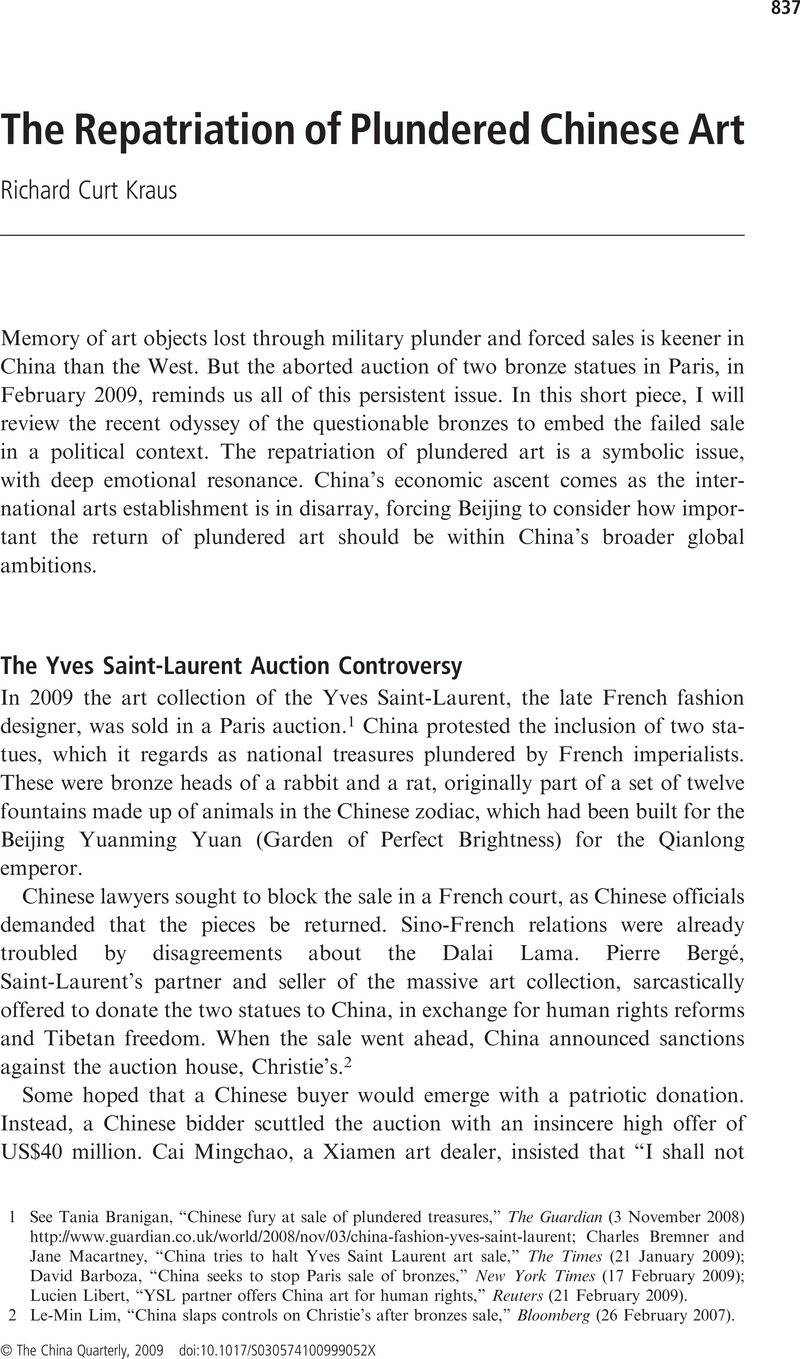Article contents
The Repatriation of Plundered Chinese Art
Published online by Cambridge University Press: 10 September 2009
Abstract

- Type
- Briefs
- Information
- Copyright
- Copyright © The China Quarterly 2009
References
1 See Branigan, Tania, “Chinese fury at sale of plundered treasures,” The Guardian (3 November 2008)Google Scholarhttp://www.guardian.co.uk/world/2008/nov/03/china-fashion-yves-saint-laurent; Bremner, Charles and Macartney, Jane, “China tries to halt Yves Saint Laurent art sale,” The Times (21 January 2009)Google Scholar; Barboza, David, “China seeks to stop Paris sale of bronzes,” New York Times (17 February 2009)Google Scholar; Libert, Lucien, “YSL partner offers China art for human rights,” Reuters (21 February 2009)Google Scholar.
2 Lim, Le-Min, “China slaps controls on Christie's after bronzes sale,” Bloomberg (26 February 2007)Google Scholar.
3 Zhong, Wu, “China's renegade patriot faces backlash,” Asia Times (11 March 2009)Google Scholarhttp://www.atimes.com/atimes/China/KC11Ad01.html.
4 Lim, Le-Min, “Chinese art dealer in unpaid YSL bronzes furor weeps,” Bloomberg (10 March 2009)Google Scholar; Crow, Kelley, “Bidder refuses to pay, stating protest of looting,” Wall Street Journal (3 March 2009)Google Scholar.
5 “The Yves Saint-Laurent sale” (5 March 2009), www.economist.com.
6 The Yuanming Yuan is often known in English as the “Old Summer Palace,” to distinguish it from the present Summer Palace which was imagined to have replaced it. In fact, the “new” Summer Palace (the Yihe Yuan) began as a part of the older garden, and the Yuanming Yuan was never a summer palace, but the favoured residence and political centre for the Qing emperors.
7 See Cécile, and Beurdeley, Michel, Giuseppe Castiglione: A Jesuit Painter at the Court of the Chinese Emperors (Rutland, Vermont: Charles E. Tuttle Company, 1971)Google Scholar.
8 For greater detail on the saga of these statues, see my “When legitimacy resides in beautiful objects: repatriating Beijing's looted zodiac animal heads,” in Gries, Peter and Rosen, Stanley (eds.), State and Society in 21st Century China: Crisis, Contention, and Legitimation (London: Routledge, 2004), pp. 195–215Google Scholar. A revised version of this volume and essay, retitled “The Politics of Art Repatriation: Nationalism, State Legitimation, and Beijing's Looted Zodiac Animal Heads,” is forthcoming in 2010.
9 Quoted in Wong, Young-tsu, Paradise Lost: The Imperial Garden Yuanming Yuan (Honolulu: University of Hawai'i Press, 2001), p. 149Google Scholar.
10 See Hevia, James L., Cherishing Men from Afar: Qing Guest Ritual and the Macartney Embassy of 1793 (Durham: Duke University Press, 1995)Google Scholar; Peyrefitte, Alain, The Immobile Empire (New York: Alfred A. Knopf, 1992), pp. 135–51Google Scholar.
11 See Hitchens, Christopher, The Elgin Marbles: Should They be Returned to Greece? (New York: Verso. 1998)Google Scholar; Chamberlin, Russell. Loot! The Heritage of Plunder (New York: Facts on File, 1983)Google Scholar.
12 See James Hevia, “Loot's Fate,” pp. 319–45. Hevia reminds us that the bulk of the “British” troops were in fact Indian, which adds a piquant complexity to the event.
13 McCausland, Shane, “The admonitions scroll: ideals of etiquette, art and empire from early China,” Orientations, Vol. 32, No. 5 (June 2001), pp. 26–27Google Scholar.
14 Charles Mason says that Captain Johnson may have received the scroll as gift, but also that it may have been war booty. No connoisseur, Johnson took the scroll to the British Museum for an evaluation not of the painting, but of a jade toggle on its wrapper. See Mason, Charles, “The British Museum admonitions scroll: a cultural biography,” Orientations, Vol. 32, No. 5 (June 2001), pp. 30–34Google Scholar.
15 Recent books examining the issue of restoring art plundered from Jews during the Second World War include Nicholas, Lynn H., The Rape of Europa: The Fate of Europe's Treasures in the Third Reich and the Second World War (New York: Knopf, 1994)Google Scholar; Feliciano, Hector, The Lost Museum: The Nazi Conspiracy to Steal the World's Greatest Works of Art (New York: Basic Books. 1997)Google Scholar; and Chesnoff, Richard Z., Pack of Thieves: How Hitler and Europe Plundered the Jews and Committed the Greatest Theft in History (London: Weidenfeld and Nicolson, 2000)Google Scholar.
16 See Waxman, Sharon, Loot: The Battle over the Stolen Treasures of the Ancient World (New York: Times Books, 2008)Google Scholar.
17 See Mason, Christopher, The Art of the Steal: Inside the Sotherby's–Christie's Auction House Scandal (New York: Putnam's, 2004)Google Scholar.
18 Kennedy, Randy, “Pact on Chinese treasures wins praise,” New York Times (17 January 2009)Google Scholar.
19 Cuno, James, Who Owns Antiquity? Museums and the Battle over our Ancient Heritage (Princeton: Princeton University Press, 2008)Google Scholar. An earlier brief for the museum world and against change is Murphy, J. David, Plunder and Preservation: Cultural Property Law and Practice in the People's Republic of China (Hong Kong: Oxford University Press, 1995)Google Scholar.
20 “Woguo jiang she haiwai ‘zhuibao’ jigou” (Our country is to set up an organ for “recovering national treasures” from abroad), Gongren ribao (21 May 2000).
21 See Jeannette Shambaugh Elliott, with Shambaugh, David, The Odyssey of China's Imperial Treasures (Seattle: University of Washington Press, 2005)Google Scholar.
- 3
- Cited by


